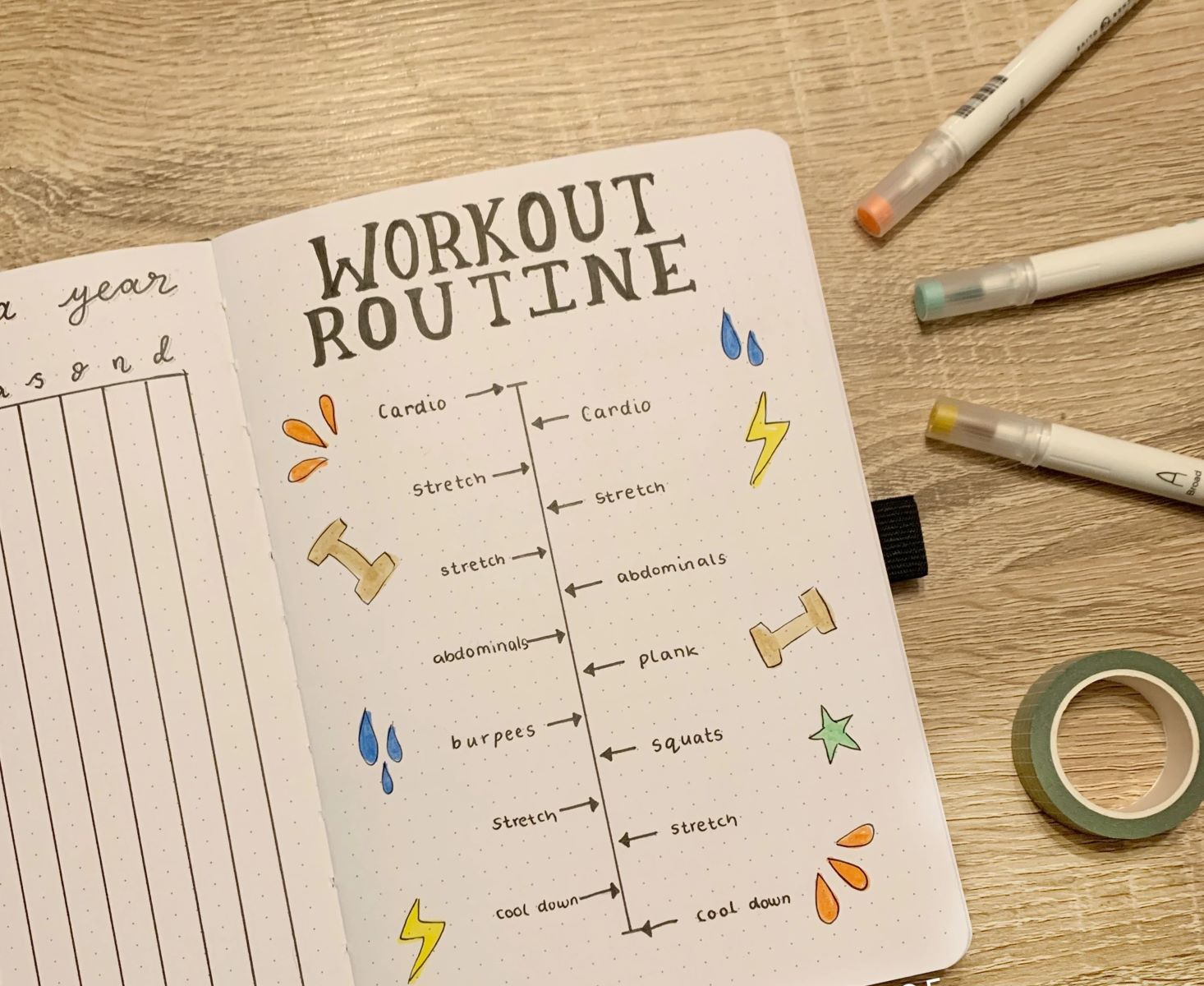

Featured
How To Split Your Workout Days
Modified: March 1, 2024
Learn how to effectively split your workout days for optimal results. Featured workouts and tips to help you maximize your gym sessions.
Introduction
When it comes to working out, there are various approaches you can take to achieve your fitness goals. One popular method is splitting your workout days, where you focus on different muscle groups or fitness modalities on different days of the week. This approach can offer numerous benefits for both beginners and seasoned fitness enthusiasts.
By dividing your workouts into specific muscle groups or training styles, you can target and prioritize certain areas to promote muscle growth, strength, and overall fitness. Splitting your workout days also allows for better recovery time, reducing the risk of overtraining and injury. Additionally, it allows you to incorporate different exercises and training techniques, keeping your workouts fresh and engaging.
The key to splitting your workout days effectively lies in designing a well-balanced and customized plan that aligns with your goals and fitness level. Whether you want to focus on building strength, increasing muscle mass, or improving overall athleticism, the right workout split can help you optimize your efforts and achieve your desired results.
In this article, we will explore the different types of workout splits, how to determine the best split for you, and how to structure your workout days for maximum effectiveness. We will also provide some tips to ensure that you are making the most out of your split workouts and avoiding common mistakes that can hinder your progress.
So, if you’re ready to take your fitness journey to the next level and make your workouts more efficient and effective, let’s dive into the world of split workout days.
Benefits of Splitting Your Workout Days
There are numerous benefits to incorporating a split workout routine into your fitness regimen. By dividing your workouts into specific muscle groups or training modalities, you can optimize your training and achieve better results. Here are some of the key benefits of splitting your workout days:
- Targeted Muscle Development: One of the main advantages of a split workout routine is the ability to specifically target and prioritize different muscle groups. By dedicating separate days to different areas of the body, such as upper body, lower body, or specific muscle groups, you can focus on developing strength and muscle mass in those specific areas.
- Increased Training Volume: Splitting your workout days allows you to increase your training volume for each muscle group. Instead of working every muscle group in a single session, you can devote more time and energy to each group by spreading the workload across multiple days. This can lead to greater muscle stimulation and growth over time.
- Enhanced Recovery: Proper rest and recovery are essential for muscle growth and injury prevention. By splitting your workouts, you allow more time for each muscle group to recover before training them again. This reduces the risk of overtraining and gives your muscles the chance to repair and grow stronger.
- Improved Focus and Intensity: When you focus on specific muscle groups or training styles during each workout, you can give those areas your full attention and effort. This allows for greater focus and intensity, leading to more effective and efficient workouts. It also helps prevent boredom by constantly challenging your body in different ways.
- Flexibility and Adaptability: Split workout routines offer flexibility and adaptability, allowing you to customize your training schedule to fit your lifestyle. You can adjust the frequency and duration of your workouts to accommodate other commitments, such as work, family, or social activities. This makes it easier to maintain a consistent exercise routine over the long term.
By taking advantage of these benefits, you can maximize your efforts in the gym and make significant progress towards your fitness goals. However, it’s important to note that the specific benefits may vary depending on factors such as your fitness level, goals, and overall training program.
How to Determine Your Split
Choosing the right split for your workout routine is crucial in order to maximize your results and accommodate your individual needs. Here are some steps to help you determine the most suitable split for your goals:
- Define Your Goals: Start by clearly identifying your fitness goals. Are you looking to build overall strength, increase muscle mass, improve endurance, or enhance athletic performance? Understanding your objectives will guide you in selecting the appropriate split that aligns with your desired outcomes.
- Assess Your Fitness Level: Consider your current fitness level and experience with different types of exercises. If you are new to fitness or have limited experience, it may be beneficial to begin with a full-body split to build a solid foundation. For more advanced individuals, a more specific split targeting individual muscle groups or training styles may be appropriate.
- Evaluate Your Schedule: Take into account your schedule and availability for workouts. Determine how many days per week you can commit to training, and allocate those days effectively for your split. Consider any other obligations or activities that may affect your training consistency.
- Consider Recovery Time: Allow sufficient time for muscle recovery between workouts. Depending on your fitness level and training intensity, you may need 24-48 hours of rest before targeting the same muscle group again. Design your split accordingly to ensure enough recovery time for optimal results.
- Experiment and Adjust: Recognize that finding the ideal split may require some trial and error. It’s important to listen to your body and make adjustments as needed. If you’re not seeing the desired results or experiencing excessive fatigue or muscle soreness, consider modifying your split or seeking guidance from a fitness professional.
Remember, there is no one-size-fits-all approach to determining your split. It should be tailored to your specific goals, fitness level, and schedule. Be open to experimenting with different splits until you find the one that works best for you.
Upper Body Workout Split
An upper body workout split focuses on targeting and developing the muscles in your upper body, including the chest, shoulders, back, and arms. This split is ideal for individuals looking to build upper body strength, enhance muscle definition, and improve overall aesthetics. Here’s an example of an upper body workout split:
- Day 1: Chest and Triceps: On this day, you would primarily focus on exercises such as bench press, dumbbell flyes, push-ups, and tricep dips to target the chest and triceps.
- Day 2: Back and Biceps: This day would consist of exercises such as pull-ups, bent-over rows, lat pulldowns, and bicep curls to work the back and biceps.
- Day 3: Shoulders and Abs: On this day, exercises like shoulder presses, lateral raises, front raises, and planks can be incorporated to develop the shoulders and strengthen the core.
- Day 4: Rest or Active Recovery: Allow your upper body to rest and recover on this day. You can engage in light cardiovascular activities or focus on stretching and mobility work.
This upper body workout split can be performed over a 4-day cycle, allowing for adequate recovery time between muscle groups. Adjust the sets, reps, and weights based on your fitness level and progressively challenge yourself over time.
Remember to warm up before each workout and cool down afterwards to prevent injuries and promote recovery. Incorporating a mix of compound exercises (working multiple muscle groups) and isolation exercises (targeting specific muscles) can help you achieve a well-rounded upper body workout.
Keep in mind that this is just one example of an upper body workout split, and you can customize it based on your individual preferences and goals. Consulting with a fitness professional can provide additional guidance and ensure proper form and technique.
Lower Body Workout Split
A lower body workout split is designed to target the muscles in your lower body, including the glutes, quadriceps, hamstrings, and calves. This split is perfect for individuals looking to build lower body strength, improve lower body aesthetics, and enhance overall athletic performance. Here’s an example of a lower body workout split:
- Day 1: Quadriceps and Calves: On this day, you would focus primarily on exercises such as squats, lunges, leg press, and calf raises to target the quadriceps and calves.
- Day 2: Hamstrings and Glutes: This day consists of exercises such as deadlifts, hamstring curls, hip thrusts, and glute bridges to work the hamstrings and glutes.
- Day 3: Full Body Functional: On this day, incorporate compound movements like kettlebell swings, box jumps, step-ups, and Romanian deadlifts to engage multiple muscle groups, including the lower body.
- Day 4: Rest or Active Recovery: Rest and allow your lower body to recover on this day. Engaging in light yoga or mobility exercises can help relieve muscle tension and improve flexibility.
This lower body workout split can be performed over a 4-day cycle, providing ample rest between muscle groups. Remember to adjust the intensity and volume of each exercise based on your fitness level and gradually increase the challenge as you progress.
Warm up before each workout and cool down afterward to prevent injuries and maximize recovery. It’s also essential to focus on proper form and technique, especially when performing exercises like squats and deadlifts.
Keep in mind that this is just one example of a lower body workout split, and you can customize it according to your preferences and goals. If you’re uncertain about form or need additional guidance, consider working with a qualified fitness professional.
Full Body Workout Split
A full body workout split involves targeting all major muscle groups in a single workout session. This split is ideal for individuals who have limited time for exercise or are looking for a well-rounded routine that promotes overall strength, endurance, and functional fitness. Here’s an example of a full body workout split:
- Day 1: Compound Movements: Begin with compound exercises that engage multiple muscle groups simultaneously, such as squats, deadlifts, bench press, and pull-ups. These exercises provide a solid foundation for full-body strength and muscle development.
- Day 2: Upper Body Focus: Dedicate this day to exercises that target the upper body, such as overhead presses, rows, push-ups, and bicep curls. Include both horizontal and vertical pulling and pushing movements to ensure balanced development.
- Day 3: Lower Body Focus: On this day, emphasize lower body exercises like lunges, step-ups, hamstring curls, and calf raises. Aim to work each major muscle group in the lower body to promote strength and symmetry.
- Day 4: Functional and Core Training: Incorporate functional movements and core exercises that improve stability, balance, and overall athleticism. Examples include planks, Russian twists, medicine ball slams, and kettlebell swings.
- Day 5: Rest or Active Recovery: Allow your body to rest and recover. Engage in light cardio, mobility work, or activities like swimming or yoga to promote active recovery.
This full body workout split can be performed on a 5-day cycle, with a day of rest or active recovery in between. It is essential to focus on proper form and technique for each exercise to maximize safety and effectiveness.
Remember to gradually increase the intensity and challenge of your workouts over time by increasing weights, repetitions, or difficulty level. This will help you continually progress and avoid plateaus.
While this example provides a structured full body workout split, you can tailor it to your specific preferences and goals. It’s important to listen to your body and adjust according to your fitness level and recovery ability. Consulting with a fitness professional can also provide valuable insights and personalized recommendations.
How to Structure Your Workout Days
Structuring your workout days is essential to ensure that you are effectively utilizing your time and resources in the gym. Here are some tips to help you create a well-organized and efficient workout schedule:
- Determine Training Frequency: Decide how many days per week you can devote to working out. Consider your overall schedule, commitments, and recovery needs. Aim for a minimum of three to four workout days per week to see significant progress.
- Select Your Split: Choose the workout split that aligns with your goals and preferences. Whether it’s an upper body, lower body, or full body split, ensure it suits your fitness level and allows adequate recovery for each muscle group.
- Create a Weekly Schedule: Look at your calendar and assign specific workout days for each muscle group or training focus. Distribute the workouts evenly throughout the week, and factor in rest days or days for active recovery to allow your body to recuperate.
- Warm Up and Cool Down: Prior to each workout, spend at least 5-10 minutes warming up with dynamic stretches or light cardio to increase blood flow and prepare your muscles for exercise. After your workout, cool down with static stretches to improve flexibility and aid in recovery.
- Balance Intensity: Ensure a balanced distribution of exercise intensity throughout the week. Mix high-intensity workouts with lower-intensity or active recovery days to prevent overtraining and allow your body to adapt and recover.
- Vary Your Exercises: Keep your workouts interesting and challenging by incorporating a variety of exercises for each muscle group or training focus. This not only helps prevent boredom but also ensures that you target different muscle fibers and continuously stimulate growth.
- Track Your Progress: Keep a workout journal or use a fitness app to track your workouts, including exercises, weights, sets, and reps. This allows you to monitor your progress and make adjustments to your routine as needed.
- Listen to Your Body: Pay attention to your body’s signals and adjust your workouts accordingly. If you’re feeling fatigued or experiencing pain, allow for additional rest or modify your routine. It’s important to prioritize your overall well-being and avoid pushing yourself too hard.
By structuring your workout days effectively, you can optimize your training routine and make progress towards your fitness goals. Remember, consistency and dedication are key. Stay committed to your schedule, but also be flexible and adaptable when necessary. Most importantly, enjoy the journey and celebrate your achievements along the way.
Tips for Effective Splitting
Splitting your workout days can be a highly effective way to achieve your fitness goals. To make the most out of your split routine, consider implementing the following tips:
- Set Clear Goals: Clearly define your fitness goals and tailor your split routine to align with those objectives. Whether it’s building strength, increasing muscle mass, or improving endurance, having a clear focus will help you structure your workouts effectively.
- Balance Muscle Groups: Ensure that your split routine targets all major muscle groups in a balanced manner. This will help develop overall strength and reduce the risk of muscular imbalances that can lead to injury. Include exercises that target opposing muscle groups to promote balanced development.
- Align with Recovery Needs: Allow proper recovery time for each muscle group. Avoid working the same muscle group on consecutive days to give your muscles time to repair and grow. Incorporate rest days or active recovery days into your schedule to promote overall recovery and prevent overtraining.
- Progressive Overload: Gradually increase the intensity, volume, or difficulty of your workouts over time. This principle of progressive overload ensures that your muscles continue to be challenged and stimulated for growth. Add weight, increase reps, or try more advanced variations of exercises to progress.
- Include Compound Exercises: Incorporate compound exercises that target multiple muscle groups simultaneously. Examples include squats, deadlifts, bench press, and pull-ups. These exercises provide a greater stimulus and help maximize efficiency during your workouts.
- Mix Up your Split: Periodically change your split routine to keep your workouts fresh and prevent plateaus. This can involve adjusting the number of workout days, changing the focus of your splits, or introducing new exercises. Variety challenges your muscles in different ways and encourages continuous progress.
- Focus on Form and Technique: Proper form and technique are crucial for effectiveness and safety. Take the time to learn and practice correct form for each exercise, and consider working with a qualified fitness professional to ensure you perform exercises correctly to avoid injuries and maximize results.
- Listen to Your Body: Pay attention to your body’s signals. If you’re experiencing excessive fatigue, pain, or lack of progress, reassess your training approach. Adjust your split, exercise selection, or intensity as needed to cater to your body’s individual needs.
By implementing these tips, you can optimize the effectiveness of your split routine and make significant progress towards your fitness goals. Remember that consistency, patience, and a balanced approach are key to achieving long-term success with your workouts.
Common Mistakes to Avoid
While splitting your workout days can be highly effective, there are some common mistakes that you should be aware of and avoid. By steering clear of these errors, you can ensure that your split routine is both safe and efficient. Here are some common mistakes to watch out for:
- Overemphasizing Certain Muscle Groups: It’s important to maintain balance in your split routine and avoid overemphasizing certain muscle groups at the expense of others. Neglecting certain muscle groups can lead to muscular imbalances and increase the risk of injuries.
- Neglecting Warm-Up and Cool-Down: Failing to properly warm up before your workout and cool down afterward can increase the risk of injuries and hinder recovery. Dedicate sufficient time to warm up with dynamic stretches and light cardio to prepare your muscles, and cool down with static stretches to promote flexibility and aid in recovery.
- Not Allowing Sufficient Recovery Time: While it’s essential to challenge your muscles with targeted workouts, it’s equally important to allow adequate recovery time. Overtraining can lead to diminished results, fatigue, and increased risk of injuries. Make sure to incorporate rest days or active recovery to promote proper rest and rejuvenation.
- Ignoring Proper Nutrition and Hydration: Your nutrition and hydration play a vital role in your performance and recovery. Failing to fuel your body with the necessary nutrients and staying hydrated can impact your energy levels, muscle recovery, and overall progress. Prioritize a balanced diet and adequate hydration to support your training.
- Skipping Mobility and Flexibility Work: Mobility and flexibility exercises are often overlooked but are crucial for maintaining joint health, preventing injuries, and enhancing performance. Incorporate exercises like stretching, foam rolling, and yoga into your routine to improve overall mobility and flexibility.
- Not Progressing Over Time: To see continuous progress, it’s important to challenge yourself and progressively increase the intensity or difficulty of your workouts. Failing to consistently push your limits can lead to stagnation. Gradually increase weights, reps, or difficulty level over time to ensure ongoing growth and improvement.
- Relying Solely on Split Training: While splitting your workout days can be effective, it doesn’t mean you should neglect other aspects of fitness. Incorporate other forms of exercise, such as cardiovascular training and functional movements, to improve overall fitness and prevent imbalances.
- Ignoring Proper Form and Technique: Improper form and technique not only diminish the effectiveness of your exercises but also increase the risk of injuries. Take the time to learn the correct form for each exercise and prioritize proper technique throughout your workouts. Seek guidance from a fitness professional if needed.
Avoiding these common mistakes will help you get the most out of your split routine. Remember to listen to your body, prioritize rest and recovery, maintain balance, and focus on overall wellbeing. By doing so, you can achieve improved strength, fitness, and overall health.
Conclusion
Splitting your workout days is a highly effective approach to optimize your training and achieve your fitness goals. Whether you choose an upper body, lower body, or full body workout split, this method allows you to target specific muscle groups, increase training volume, and improve overall fitness.
By following the tips outlined in this article, you can create a well-structured and efficient workout schedule. Consider your goals, fitness level, and recovery needs when determining your split. Ensure that you balance muscle groups, include a variety of exercises, and progressively increase the intensity over time.
Avoid common mistakes such as overemphasizing certain muscle groups, neglecting warm-up and cool-down, and skipping proper nutrition and hydration. Focus on maintaining proper form and technique, incorporating mobility work, and listening to your body to prevent injuries and promote overall well-being.
Remember, the key to success with split workouts lies in consistency, patience, and adaptability. Be open to adjusting your split routine as needed, and track your progress to stay motivated. Celebrate your achievements and embrace the journey of self-improvement through fitness.
So, if you’re ready to maximize your workouts and take your fitness to the next level, start incorporating split training into your routine. Enjoy the benefits of targeted muscle development, increased training volume, enhanced recovery, and improved focus. With dedication and perseverance, you’ll be well on your way to achieving the strong, healthy, and fit body you desire.









